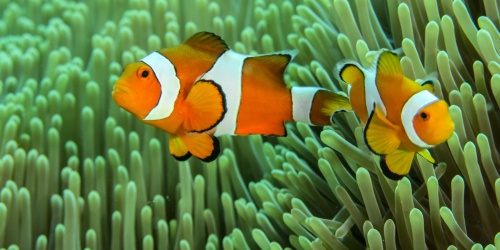
Leafy Sea Dragon - Photo the Ocean Agency / Adobe
What is a leafy sea dragon? The leafy sea dragon (Phycodurus eques) is one of three species of sea dragon found only in Australian waters and nowhere else in the world. the others being the weedy sea dragon and the ruby sea dragon. Despite its fearsome name, it is incredibly beautiful in shape and colouring and its camouflaging appendages give it a fragile appearance. It is a relative of the seahorse and belongs to the pipefish family Sygnathidae.
What does it look like? Leafy sea dragons get their common name from the leaf-like appendages on their bodies. They resemble floating pieces of seaweed, which makes them difficult for predators to find in their natural habitat (it also makes them difficult for divers to see too, so anyone who sees one swimming in the wild is exceptionally lucky!). Most adults are green to yellowish-brown with thin bands or stripes across the body. They can reach a total length of 45 centimetres.
Where does it live? The leafy sea dragon lives among rocky reefs, seaweed beds, seagrass meadows and on sand patches near weed covered reefs where it looks like drifting seaweed. This species has only been recorded from the southern coastline of Australia, from Jurien Bay Marine Park to Wilsons Promontory in Victoria. In WA, most sightings of leafy sea dragons are in Ngari Capes Marine Park (from Busselton to Augusta) and you might also be lucky enough to find one in Shoalwater Islands Marine Park or Marmion Marine Park.
What does it eat and how: The leafy sea dragon sucks up its prey using its long pipe-like snout and small mouth. Its favourite food is mysid shrimps or sea lice. These shrimps feed on red algae (seaweeds) that thrive in the shade of the kelp forests where the sea dragons live.
Threats: Because leafy sea dragons are such fascinating and unique creatures, some people illegally collect them for their aquariums (they are totally protected). Unfortunately, leafy sea dragons that are removed by divers usually die quickly because their captors do not provide them with the correct live food daily. Other major threats to leafy sea dragons include pollution and excessive fertiliser run-off, as well as loss of their seagrass habitat.
Behaviour: Being slow moving, they rely heavily on camouflage for survival, but are also equipped with several long sharp spines along the side of the body which are thought to be used to defend themselves against attacking fish. They are also able to change colour to match their surroundings. Leafy sea dragons are fascinating to watch and their movements appear to mimic the swaying movements of seaweed and kelp. They steer and turn by moving the tiny, translucent fins along the side of the head and move through the water using the dorsal fins along the spine. They are one of the only animals in the world that hide by moving! Sea dragons have eyes that can move independently of one another (while one eye looks one way the other one can look in a completely different direction).
Breeding and caring for young: The most unusual fact about the leafy sea dragon is that the male becomes pregnant and gives birth to live young. During mating the female lays 100 to 250 eggs onto a special brood patch on the underside of the male's tail, where they are fertilised. During each breeding season, male leafy sea dragons will hatch two batches of eggs. The male incubates the eggs for 4-6 weeks and 'gives birth' to miniature juvenile versions of sea dragons. As soon as a baby sea dragon leaves the safety of its father's tail, it is independent and receives no further help from its parents. At birth the young are around 20 millimetres long, which makes them vulnerable to predators like fish, crustaceans and sea anemones (only about one in 20 survive to become adults). But young sea dragons grow fast, reaching 20 centimetres after one year and reach their mature length at two years. It is not known how long wild sea dragons live.
Conservation status: Leafy sea dragons are listed as Least Concern on the IUCN Red List of Threatened Species.
How you can protect the leafy sea dragon: The leafy sea dragon is a rare sight and a very fragile creature. Handling of any sort is discouraged due to the likelihood of injuring this animal. It does seem to enjoy having its picture taken though! So scientists can keep a watchful eye on sea dragon populations please report any sightings of either sea dragon species (including dead ones found washed up on the beach) to www.dragonsearch.asn.au.



























